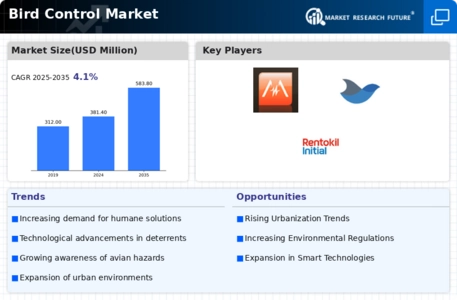Agricultural Impact
The agricultural sector is profoundly influenced by bird populations, which can lead to significant crop damage. The Bird Control Market is likely to see increased demand for effective bird management solutions as farmers seek to protect their yields. Studies indicate that birds can cause losses of up to 20% in certain crops, prompting farmers to adopt various control measures. This trend is particularly evident in regions where agriculture is a primary economic driver. As the need for food security intensifies, the Bird Control Market may experience growth as agricultural stakeholders invest in innovative bird control technologies to safeguard their harvests.
Public Health Concerns
Public health concerns related to birds, particularly in urban settings, are emerging as a critical driver for the Bird Control Market. Birds can be vectors for various diseases, which poses risks to human health. The presence of birds in populated areas can lead to the spread of zoonotic diseases, prompting local governments and health organizations to implement bird control measures. Reports suggest that the economic burden of bird-related diseases can be substantial, leading to increased healthcare costs. As awareness of these health risks grows, the Bird Control Market is likely to expand as stakeholders prioritize public health and safety through effective bird management strategies.
Increasing Urbanization
The rapid pace of urbanization appears to be a significant driver for the Bird Control Market. As cities expand, the availability of nesting sites and food sources for birds increases, leading to higher populations in urban areas. This trend necessitates effective bird control measures to mitigate potential damage to property and public health. According to recent estimates, urban areas are expected to house over 68% of the world's population by 2050, which could exacerbate conflicts between humans and birds. Consequently, municipalities and businesses are likely to invest in bird control solutions to address these challenges, thereby propelling the growth of the Bird Control Market.
Environmental Regulations
Environmental regulations are playing a pivotal role in shaping the Bird Control Market. As governments implement stricter guidelines to protect wildlife, businesses must adapt their bird control strategies to comply with these regulations. This shift may lead to increased demand for environmentally friendly bird control solutions that align with conservation efforts. The Bird Control Market could see growth as companies invest in sustainable practices that minimize harm to non-target species. Furthermore, compliance with these regulations may drive innovation in the development of new products and services, ultimately benefiting the Bird Control Market.
Technological Innovations
Technological innovations are reshaping the Bird Control Market, offering new and effective solutions for managing bird populations. Advances in technology, such as the use of drones for monitoring and the development of automated bird deterrents, are becoming increasingly prevalent. These innovations not only enhance the efficiency of bird control measures but also reduce the reliance on traditional methods, which may be less effective. The market for these technologies is projected to grow as businesses and municipalities seek to adopt more sophisticated approaches to bird management. As a result, the Bird Control Market is likely to benefit from ongoing research and development in this area.


















Leave a Comment